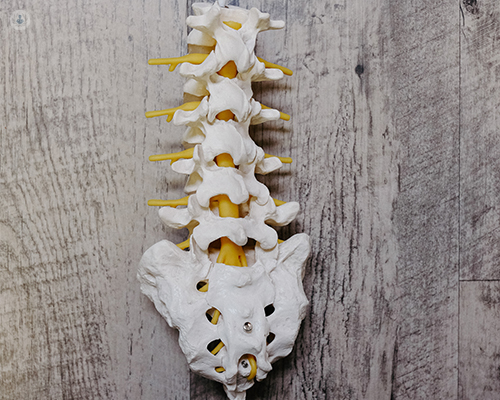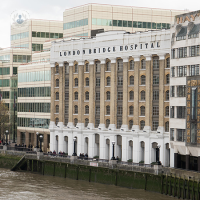Lumbar nerve root block
Mr Sinan Barazi - Neurosurgery
Created on: 07-16-2020
Updated on: 04-26-2023
Edited by: Sophie Kennedy
A lumbar nerve root block, also known as a transforaminal epidural, is an injection of local anaesthetic and anti-inflammatory steroids to provide pain relief. It is administered to the ventral epidural space and around exiting nerve roots that run on either side of the lumbar section of spine. By providing pain relief, this should help patients to improve their mobility.

Why is a lumber nerve root block needed?
An injection into the lumbar nerve root may be done for both diagnostic and therapeutic reasons. If a doctor cannot determine the cause of pain from traditional methods such as an MRI or CT scan, they can use a lumbar nerve root block to identify the source of the pain using temporary numbing agents. Therapeutic reasons can include:
- pain in legs and/or back
- inflamed nerve root
- scoliosis
- nerve compression
- bone spurs
- large disc herniation
- degenerative changes in vertebrae
- foraminal stenosis
- lateral disc herniation
- sciatica
- others
There are other conditions which a lumbar nerve root block may help treat. Speak with your GP to see if it best for you and your condition.
How is the injection procedure done?
A lumbar nerve root block procedure is typically done as a day case. The patient will lie on their stomach with their back facing up. The area of skin where the injection will be made is cleaned thoroughly with an antiseptic and it will be numbed. Before the injection begins, a live x-ray will be used by the physician to help guide the needle to the nerve root via the best path and to avoid any damage to the spine.
A thin needle is used to insert contrast dye behind the nerve root to ensure the medication flows where it is intended. Depending on the procedure, an amount of either anaesthetic, steroid, or a combination of both will be injected. If you are not under sedation, it is possible you will feel pressure in the arm or neck for a few moments. Usually, recovery is 20 to 30 minutes, and it is common to feel some temporary numbness or heaviness in the leg for a few hours afterwards.
Once the numbness has worn off, some of the pain may return. It is possible that it takes a couple days to a couple weeks for the corticosteroids to take the intended effect. If you were previously taking pain medication, continue to do so until the lumbar nerve root block is working. It is important to not stop any regular medication abruptly, but always check with your GP about the method that is best for you.
What are the possible risks, complications, and side effects?
Complications tend to be rare, but they may include:
- headache
- infection
- blood pressure changes
- bleeding
- discomfort at needle injection site
- allergic reaction
- injury to a blood vessel
- nerve or dural injury
Side effects to the steroid can be:
- facial flushing
- fluid retention
- insomnia
- low-grade fever (less than 38º C)
- temporary changes to menstrual cycle
- temporary elevated blood sugar levels in those with diabetes
What can you expect after having the injection?
Once you and your GP are happy with your mobility, you will be allowed to go home. This may take a few hours. Plan to rest for the remainder of the day and do not over-exert yourself. There may be soreness around the injection site for a couple days. Do not take a bath for the first twenty-four hours after the procedure, but you can shower. Be aware of any unusual signs or symptoms afterwards, and report anything strange to your GP. If any serious symptoms start to happen, seek a medical professional.
Repeated lumbar nerve root block injections and frequency will depend on your medical history and medical necessity. Some health conditions may impact this.
What is the success rate of lumbar nerve root block?
A lumbar nerve root block procedure is considered to be quite safe and appropriate for many painful conditions. Some studies have shown that forty-six per cent of patients reported significant improvement in pain and functionality. Other studies have shows up to eighty-four per cent of patients reported effective pain decrease.
It is important to keep in mind that everyone responds to lumbar nerve root block injections differently. Some people may feel relief immediately, whereas some others may require more than one injection to feel the effects. The injection is often successful, but each patient will experience a different level of success taking into account how long they were experiencing chronic pain, their age, their current medical conditions, and if being combined with any other forms of treatment.





